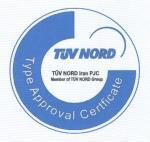Quality Control
1- Hardness test
The aim behind this process is to inrease the hardness of cynlinders' surface.
2-Magnetic particle inspection:
A magnetic particle test is used to inspect the wall and the top and the bottom of each cylinder.
THis test employs magnetic particle solutions and ultra violet lights.
3-Ultrasonic testing:
To ensure lack of defects on and under the surface, and also to measure the thickness of cylinder's wall an Ultrasonic Test is used.
4- Hydrostatic test:
To make sure that no leakage or unexpected form change occurs under internal pressure, each cylinder is tested
hydrostatically for about 300 times.
Pressure should be maintained to a sufficiently long period (at least 30 seconds).
5- Visual inspection:
A visual inspection of external and internal surfaces of cylinders is done to control lack of defects on the surface such as deformations, splits, and scratches.
6- Explosion test:
The aim behind this explosion is to match the cylinder's resistance with the ECER110 agains rupture during the hydrostatic pressure test.
7- Resistance test:
The aim of doing this test is to test the resistance of the cylinder against cyclic pressure .
in this unit cylinders are under pressure in an evironmental temperature between 20 to 260 pressure unit.
During the operation the cylinder shouldn't be leaked or defected before reaching the 15000 pressure unit.
8- fire test:
When cylinders are produced, they are equipted with a kind of protection system agianst fire. Cylinders are also
tested by fire.
Remember: Since it is possible that the cylinder may repture ,this test is done under caution.
9- Penetration test:
In this phase a fully filled cylinder with the compressed gas is going to be under shot with a bullet having about 62.7mm to test the cylinder.
10- Coating performance tests:
This machine is located in the chemistry lab which measures the color resistance against curvature.
11- Tensile test:
This device is located in Mechanical Laboratory which is used to do the tensile, compression, and bending test of samples that are cut from cylinders.
12- Impact test:
This device is located in Mechanical Laboratory which is used to measure the absorbed energy during breaking the sample.






 Abedi Machine
Abedi Machine